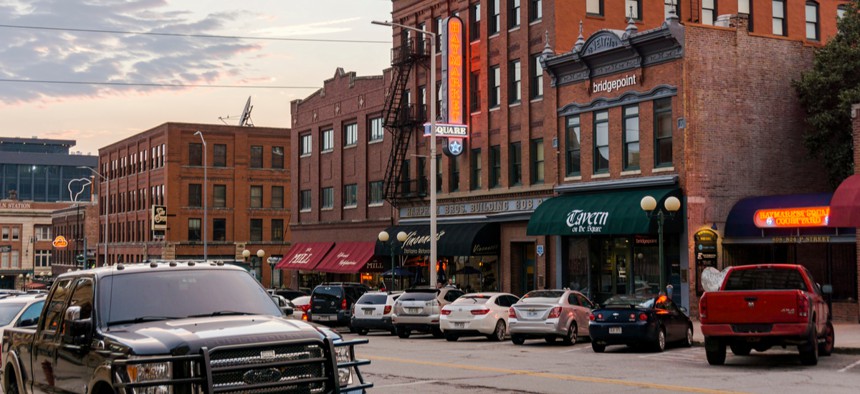Economists Remain Worried About Slow-Growing Middle Class

The Haymarket district in Lincoln, Nebraska. Victor Wong/Shutterstock

Connecting state and local government leaders
By 2017, the number of households still had not recovered to the levels of 2000.
This article was originally published Stateline, an initiative of The Pew Charitable Trusts.
Most states saw growth in the middle class between 2016 and 2017, but the number of households in that group still had not recovered to the levels of 2000.
Only Nebraska and the District of Columbia had a middle class bigger than in 2000, according to a Stateline analysis of American Community Survey microdata at IPUMS USA.
The plight of the middle class, which has yet to regain financial ground lost during the Great Recession, is of increasing concern to economists. The Federal Reserve Bank of Chicago held a conference this month to discuss policy solutions to problems Federal Reserve Chairman Jerome Powell called “crucial” for the nation to tackle in coming years.
“The kind of generational improvements in living standards that were long the hallmark of the American middle class have steadily diminished,” Powell said at the conference.
Between 2016 and 2017, Nebraska’s middle class grew 4 points to 58% of households, the biggest increase and the largest middle class in the nation. The District of Columbia’s middle class grew 3 points to 44% of households, the second biggest increase. Both areas gained in the middle mostly because of decreases in higher-income brackets, as did Maine, which grew 2 points to a 54% middle class.
Vermont, on the other hand, saw its middle class grow 2 points, mostly because of decreases in the bottom income group.
Growth in the size of the middle class is not as important as whether that growth comes from people moving up from lower-income groups or falling from higher groups, argues Richard Reeves, director of the Future of the Middle Class Initiative at the Brookings Institution, in an essay published last month on the think tank’s website.
For instance, the middle class shrank by a similar amount since 2000 in San Francisco and Detroit, Reeves wrote, but with different consequences.
“It was for opposite reasons: in San Francisco because more people got rich; in Detroit because more people got poor,” Reeves wrote. “To say simply that the middle class is ‘shrinking’ in each place doesn’t tell us very much.”
Even Nebraska and the District of Columbia’s success in growing the middle class may have been fleeting.
Preliminary indications for 2018 show little income growth in Nebraska as the agriculture-dependent state suffers from stagnant income in farm families. Sales of soybeans and other crops to China have suffered in the trade wars, and low oil prices have kept a lid on corn-based ethanol prices.
Washington, D.C., also suffered from drops in federal government employment in 2018.
Some of the challenges for the middle class outlined by the Fed: rising inequality and declining economic mobility — only half of earners today make more than their parents did.
College education can be a leg up, but rising tuition debt makes it harder than ever. Finally, success is clustered in certain families and neighborhoods, with ingrained privilege making it harder for others to break into the middle class.
“The prospect of moving up the economic ladder depends on factors beyond effort and talent,” Powell, the Fed chairman, said.
After losing ground in 49 states—all but Wyoming—between 2000 and 2013, the U.S. middle class is still slowly clawing its way back. Stateline defines middle class as households between two-thirds and twice the median size-adjusted income for the state.
Thirty-three states had a middle class that encompassed more than half of households in 2017, up from 28 in 2013, but still down from 43 states in 2000.
As of 2018, national household wealth, which includes homes and other assets as well as income, had yet to recover to the 2007 level before the recession, according to a Federal Reserve Board study released this month and presented by Federal Reserve Governor Lael Brainard.
Higher-income earners recovered by 2013. The study defined households in the 40th to 70th percentile range of household wealth as middle-income.
Those with less than middle income are even further behind, according to the Fed household wealth analysis.
At the end of 2018, according to the study, the average middle-income household had $340,000 in wealth, while the average household in the top 10% had $4.5 million, more than 13 times as much, up from 7 times as much in 1989.
“Even modest unexpected expenditures could be disruptive for many middle-income families,” the study concluded. It pointed to unpublished survey data suggesting that a third of middle-income families would have to borrow money, sell something or be unable to pay an unexpected $400 expense.
And only a quarter of middle-income homes have enough cash on hand to cover six months of expenses, the amount of savings suggested by financial advisers.
Other economists also are expressing alarm about the plight of the middle class.
A new Brookings study found that between 1979 and 2016, income doubled for the top 10% of earners but rose only 20% for the bottom half. The ultrarich may have done even better because of hidden offshore accounts, the study noted.
One answer, suggested the author of the report released last week, Heather Boushey, chief economist at the Washington Center for Equitable Growth, would be to design economic statistics that measure economic growth for all segments of society. Current government statistics can show growth even when most people are not getting the benefit, she wrote.
“If we do not change the way we conceptualize and therefore measure economic progress, we are unlikely to have very much of it,” Boushey wrote. “Better, fairer growth measures are a vital step towards better, fairer growth.”

NEXT STORY: Legislation Would Restore the Tax Break for Bonds Used to Refinance State and Local Debt




